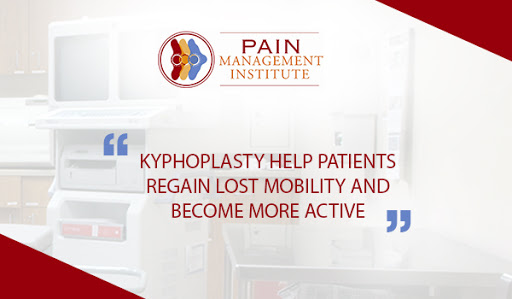Kyphoplasty is the procedure used to treat painful vertebral fractures caused by excessive pressure in the spinal column, which commonly results in osteoporosis. The kypholplasty is done by a physician using imaging guidance to inject a cement mixture in the fracture bone. With the help of Kyphoplasty the patients regain lost mobility and become more active
At the Pain Management Institute, the Kyphoplasty procedure is done by Dr Zaki Anwar, Anesthesiologist, Founder of the Pain Management Institute. He will first diagnose your condition with the help of imaging or physical exam. He will instruct you how to prepare and discuss with your physician if there is any possibility of you being pregnant or any prior medical records and breakout. He might advise you to stop taking any blood thinning medications or pain killers are restricting you from eating or drinking anything a few hours before the procedure take regular medications with a sip of water, don’t wear any jewelry or metallic objects, wear light loose clothes take someone to drive you home
What is Kyphoplasty?
When the vertebral disc is fractured the bone becomes compressed causing severe pain. These compression fractures leads to collapse the disc space between one or two vertebrae and result in osteoporosis in the long term. Osteoporosis is a disease that causes the normal bone to decay and becomes vulnerable to breaking easily
During the Kyphoplasty an air balloon is first inserted to create a space in the fracture and then the cement is injected into the space following the removal of the balloon. Generally Kyphoplasty is recommended after other conventional treatments have failed such as plenty of bed rest, wearing a brace, physical workout and pain killers. Kyphoplasty can be performed instantly in patients with unbearable pain who require hospitalization or other conventional treatments have failed
Kyphoplasty is also performed on patients who:
- Are elderly or frail and will likely have impaired bone healing after a fracture
- Have a vertebral compression due to a malignant tumor
- Suffer from osteoporosis due to long-term steroid treatment or a metabolic disorder
Kyphoplasty should be completed within eight weeks of the acute fracture for the highest chances of successful treatment.
Risks
Any procedure where the skin is injected involves a risk of infection, however this only happens in 1 of 1000 patients. A very negligible amount of cement can leak from the vertebral bone, potentially it doesn’t cause any problem, but if the leakage spreads to the spinal canal, blood vessels and lungs resulting in perilous consequences

